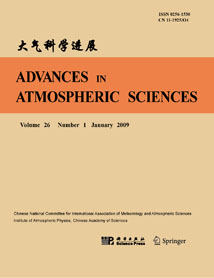| [1] |
Ding Aiju, Wang Mingxing,
1996: Model for Methane Emission from Rice Fields and Its Application in Southern China, ADVANCES IN ATMOSPHERIC SCIENCES, 13, 159-168.
doi: 10.1007/BF02656859
|
| [2] |
ZHANG Dingyuan, LIAO Hong, WANG Yuesi,
2014: Simulated Spatial Distribution and Seasonal Variation of Atmospheric Methane over China: Contributions from Key Sources, ADVANCES IN ATMOSPHERIC SCIENCES, 31, 283-292.
doi: 10.1007/s00376-013-3018-y
|
| [3] |
Zheng Xunhua, Wang Mingxing, Wang Yuesi, Shen Renxing, Li Jing, J. Heyer, M. Koegge, H. Papen,
2000: Mitigation Options for Methane, Nitrous Oxide and Nitric Oxide Emissions from Agricultural Ecosystems, ADVANCES IN ATMOSPHERIC SCIENCES, 17, 83-92.
doi: 10.1007/s00376-000-0045-2
|
| [4] |
Surachai SATHITKUNARAT, Prungchan WONGWISES, Rudklao PAN-ARAM, ZHANG Meigen,
2006: Carbon Monoxide Emission and Concentration Models for Chiang Mai Urban Area, ADVANCES IN ATMOSPHERIC SCIENCES, 23, 901-908.
doi: 10.1007/s00376-006-0901-9
|
| [5] |
BI Yun, CHEN Yuejuan, ZHOU Renjun, YI Mingjian, DENG Shumei,
2011: Simulation of the Effect of an Increase in Methane on Air Temperature, ADVANCES IN ATMOSPHERIC SCIENCES, 28, 129-138.
doi: 10.1007/s00376-010-9197-x
|
| [6] |
Igor Oliveira RIBEIRO, Rodrigo Augusto Ferreira de SOUZA, Rita Valèria ANDREOLI, Mary Toshie KAYANO, Patrícia dos Santos COSTA,
2016: Spatiotemporal Variability of Methane over the Amazon from Satellite Observations, ADVANCES IN ATMOSPHERIC SCIENCES, 33, 852-864.
doi: 10.1007/s00376-016-5138-7
|
| [7] |
Chuanjie YANG, Guang LI, Lijuan YAN, Weiwei MA, Jiangqi WU, Yan TAN, Shuainan LIU, Shikang ZHANG,
2022: Effects of Plant Community Type on Soil Methane Flux in Semiarid Loess Hilly Region, Central Gansu Province, China, ADVANCES IN ATMOSPHERIC SCIENCES, 39, 1360-1374.
doi: 10.1007/s00376-022-1169-4
|
| [8] |
LIU Chunyan, Jirko HOLST, Nicolas BRUGGEMANN, Klaus BUTTERBACH-BAHL, YAO Zhisheng, HAN Shenghui, HAN Xingguo, ZHENG Xunhua,
2008: Effects of Irrigation on Nitrous Oxide, Methane and Carbon Dioxide Fluxes in an Inner Mongolian Steppe, ADVANCES IN ATMOSPHERIC SCIENCES, 25, 748-756.
doi: 10.1007/s00376-008-0748-3
|
| [9] |
Denghui JI, Minqiang ZHOU, Pucai WANG, Yang YANG, Ting WANG, Xiaoyu SUN, Christian HERMANS, Bo YAO, Gengchen WANG,
2020: Deriving Temporal and Vertical Distributions of Methane in Xianghe Using Ground-based Fourier Transform Infrared and Gas-analyzer Measurements, ADVANCES IN ATMOSPHERIC SCIENCES, 37, 597-607.
doi: 10.1007/s00376-020-9233-4
|
| [10] |
Zhang Renjian, Wang Mingxing, Zeng Qingcun,
2000: Global Two-Dimensional Chemistry Model and Simulation of Atmospheric Chemical Composition, ADVANCES IN ATMOSPHERIC SCIENCES, 17, 72-82.
doi: 10.1007/s00376-000-0044-3
|
| [11] |
SHEN Shuanghe, YANG Dong, XIAO Wei, LIU Shoudong, Xuhui LEE,
2014: Constraining Anthropogenic CH4 Emissions in Nanjing and the Yangtze River Delta, China, Using Atmospheric CO2 and CH4 Mixing Ratios, ADVANCES IN ATMOSPHERIC SCIENCES, 31, 1343-1352.
doi: 10.1007/s00376-014-3231-3
|
| [12] |
Zhang Renjian, Wang Mingxing,
1999: Modeling the Sudden Decrease in CH4 Growth Rate in 1992, ADVANCES IN ATMOSPHERIC SCIENCES, 16, 242-250.
doi: 10.1007/BF02973085
|
| [13] |
SHANG Lin, LIU Yi, TIAN Wenshou, ZHANG Yuli,
2015: Effect of Methane Emission Increases in East Asia on Atmospheric Circulation and Ozone, ADVANCES IN ATMOSPHERIC SCIENCES, 32, 1617-1627.
doi: 10.1007/s00376-015-5028-4
|
| [14] |
Zheng Xunhua, Wang Mingxing, Wang Yuesi, Shen Renxing, Li Jing, J. Heyer M. Kogge, Li Laotu, Jin Jisheng,
1998: Comparison of Manual and Automatic Methods for Measurement of Methane Emission from Rice Paddy Fields, ADVANCES IN ATMOSPHERIC SCIENCES, 15, 569-579.
doi: 10.1007/s00376-998-0033-5
|
| [15] |
Sihong ZHU, Liang FENG, Yi LIU, Jing WANG, Dongxu YANG,
2022: Decadal Methane Emission Trend Inferred from Proxy GOSAT XCH4 Retrievals: Impacts of Transport Model Spatial Resolution, ADVANCES IN ATMOSPHERIC SCIENCES, 39, 1343-1359.
doi: 10.1007/s00376-022-1434-6
|
| [16] |
Xiaolong CHEN, Tianjun ZHOU,
2023: Negligible Warming Caused by Nord Stream Methane Leaks, ADVANCES IN ATMOSPHERIC SCIENCES, 40, 549-552.
doi: 10.1007/s00376-022-2305-x
|
| [17] |
Chungu Lu, Paul Schultz, Gerald L.Browning,
2002: Scaling the Microphysics Equations and Analyzing the Variability of Hydrometeor Production Rates in a Controlled Parameter Space, ADVANCES IN ATMOSPHERIC SCIENCES, 19, 619-650.
doi: 10.1007/s00376-002-0004-1
|
| [18] |
Xun ZHU,
2003: Parameterization of the Non-Local Thermodynamic Equilibrium Source Function with Chemical Production by an Equivalent Two-Level Model, ADVANCES IN ATMOSPHERIC SCIENCES, 20, 487-495.
doi: 10.1007/BF02915493
|
| [19] |
Kairan YING, Jing PENG, Li DAN, Xiaogu ZHENG,
2022: Ocean–atmosphere Teleconnections Play a Key Role in the Interannual Variability of Seasonal Gross Primary Production in China, ADVANCES IN ATMOSPHERIC SCIENCES, 39, 1329-1342.
doi: 10.1007/s00376-021-1226-4
|
| [20] |
ZENG Qingcun, CHENG Xueling, HU Fei, PENG Zhen,
2010: Gustiness and Coherent Structure of Strong Winds and Their Role in Dust Emission and Entrainment, ADVANCES IN ATMOSPHERIC SCIENCES, 27, 1-13.
doi: 10.1007/s00376-009-8207-3
|















 AAS Website
AAS Website 
 AAS WeChat
AAS WeChat 
 DownLoad:
DownLoad: